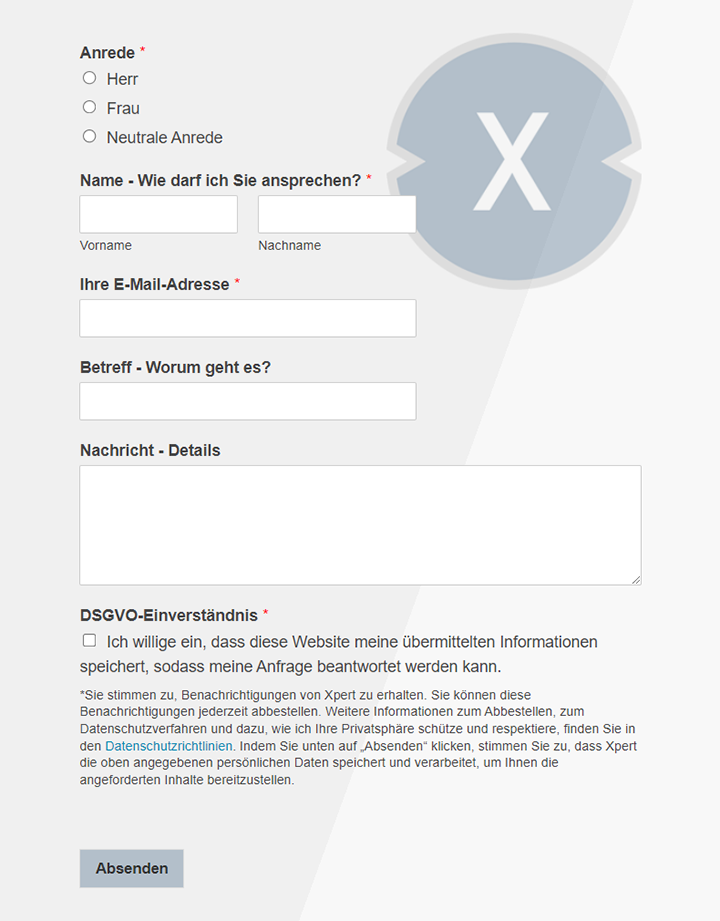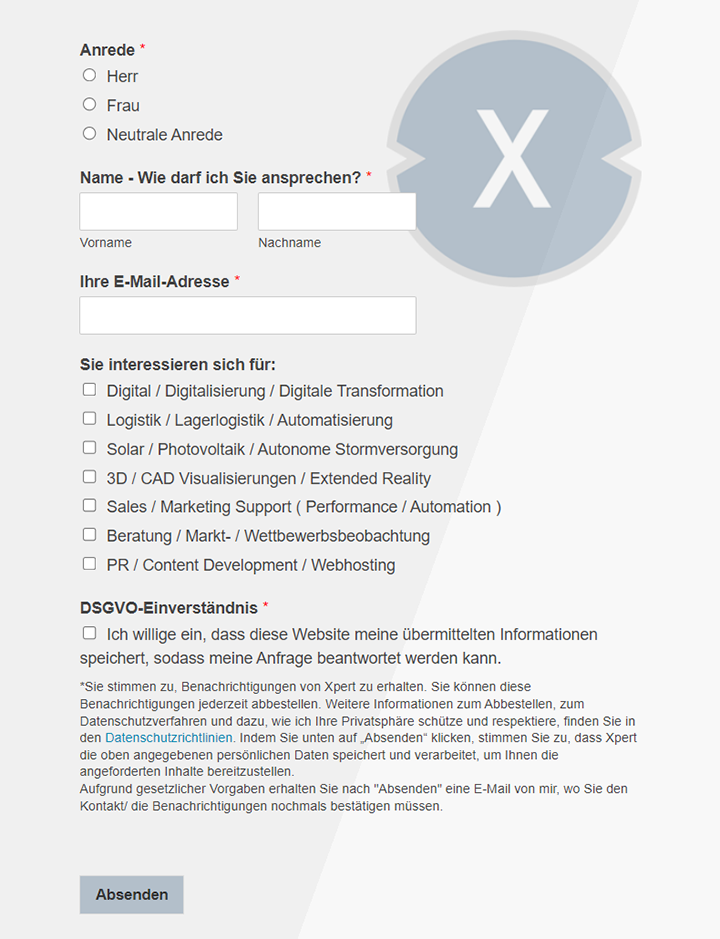Microsoft's generative Xbox Ki-Modell Muse: “World and Human Action Model” (WHAM)-The Future of Game Development
Xpert pre-release
Language selection 📢
Published on: February 20, 2025 / update from: February 20, 2025 - Author: Konrad Wolfenstein

Microsoft's exciting AI model Muse: The Future of Game Development with the “World and Human Action Model” (WHAM)-Image: Xpert.digital
Digital transformation in game development: How Microsoft's Muse can change the industry
Artificial intelligence in Games: Microsoft presents Muse with Wham
The game industry is changing and artificial intelligence plays an increasingly important role. With Muse, a generative AI model of the latest generation, Microsoft presented a promising tool that could fundamentally change the way games are being developed. Muse is based on the so -called “World and Human Action Model” (WHAM) and was developed in collaboration with the renowned developer studio Ninja Theory.
What is muse and why is it unique?
Muse is an exciting innovation because it has a profound understanding of 3D game worlds, game physics and player interactions. In contrast to conventional AI models that do specific tasks, Muse was trained to record complex relationships in games and to generate new game content based on this.
The key features of Muse include:
- Creation of realistic game worlds: Muse can generate complete, dynamic environments based on fewer inputs that react logically to player actions.
- Improved game physics: thanks to the profound analysis of collisions, movement and object dynamics, Muse ensures naturally acting game physics.
- Generation of intelligent NPC interactions: The model can create AI-controlled characters that make credible decisions based on player contacts.
- Automated gameplay optimization: Muse can adapt and improve game mechanics in real time to optimize the gaming experience.
- Adaptive balancing: Depending on the playing style of the user, the model can adapt the balancing of weapons, opponents and challenges.
The model was trained with the multiplayer game Bleeding Edge by Ninja Theory, which means that it can already access a wide range of game situations and mechanics.
Operations of muse in game development
Muse's potential applications are far -reaching and could revolutionize many processes in the game industry:
1. more efficient game development
The development of video games is often a lengthy and costly process. Muse can help developers to design game mechanics and level design faster by automatically generating suggestions for designs, NPCs and environments. As a result, developers can concentrate on fine tuning and creative design instead of dealing with time -consuming technical implementation.
2. Prototyping and rapid testing
Xbox Game Studios is currently examining how Muse can be used in early prototype development. Instead of working on a first game structure for months, Muse could create functioning game mechanics within a few days, which are then further refined by developers.
3. Player husbandry through automatic game adjustment
A central problem of many developers is long -term player loyalty. Muse can help to adapt games dynamically by generating personalized challenges based on the playing style of the user. This could mean, for example, that opponents become more intelligent or demanding in real time in order to offer a constant challenge.
4. Automatic optimization of old games for modern platforms
Many classics in gaming history can only be portrayed on modern platforms with considerable effort. Muse could help transfer old games into new environments by automatically updating code, adapting game mechanics and proposing graphics improvements.
A tool for support, not to replace creativity
Microsoft emphasizes that Muse is not intended to replace human developers, but rather serve as a supplementary tool. Creative processes such as storytelling, character design and atmospheric design remain in the hands of people. Muse only supports the technical and mechanical aspects to implement faster and more efficiently.
As Microsoft himself says: "Muse is an accelerator for innovation, not a substitute for human imagination."
Critical voices and challenges
Despite the promising options, there are also critical voices from the developer community:
- Ethics and job loss: Some industry experts fear that Muse could endanger jobs in game development in the long term because more and more tasks are being automated.
- Quality control: While Muse can help generate content faster, the question arises whether these automatically generated elements have the same quality and attention to detail as human -hand game elements.
- Technical limits: Despite Muse's enormous potential, technology is still at an early stage. Unpredictable mistakes or not entirely mechanics could affect acceptance in the gaming industry.
The future of muse and generative AI in games
Microsoft's decision to make muse about Azure Ai Foundry accessible to other developers and researchers shows that the company puts great hopes in the potential of AI. This openness could continue to promote development and lead to more and more studios muscles or similar technologies into their workflows.
The future of Muse depends on how well it succeeds in protecting the balance between automation and creative freedom. Should Microsoft successfully demonstrate that Muse is a valuable companion for developers, the model could herald a new era in game development.
The next few years will show to what extent generative AI can actually revolutionize the way games are created. However, one thing is certain: Muse has laid Microsoft an exciting foundation for the future of the gaming industry.
Our recommendation: 🌍 Limitless reach 🔗 Networked 🌐 Multilingual 💪 Strong sales: 💡 Authentic with strategy 🚀 Innovation meets 🧠 Intuition
At a time when a company's digital presence determines its success, the challenge is how to make this presence authentic, individual and far-reaching. Xpert.Digital offers an innovative solution that positions itself as an intersection between an industry hub, a blog and a brand ambassador. It combines the advantages of communication and sales channels in a single platform and enables publication in 18 different languages. The cooperation with partner portals and the possibility of publishing articles on Google News and a press distribution list with around 8,000 journalists and readers maximize the reach and visibility of the content. This represents an essential factor in external sales & marketing (SMarketing).
More about it here:
The development of game development through artificial intelligence: Microsoft's 'Muse' paves the way for a new era of creative possibilities - background analysis
Paradigm shift in the gaming world: generative AI in focus
In the fast -moving world of video game development, where innovation and creativity form the cornerstones of success, a paradigm shift is emerging. Artificial intelligence (AI) is no longer just a futuristic concept or a tool for automation repetitative tasks; She becomes a creative partner, to the co-designer who has the potential, the way, how games are designed, developed and experienced, to be fundamentally transformed. With the presentation of “Muse”, a generative AI model that was specially designed for game development, Microsoft took an important step in this direction.
Yesterday's publication of Microsoft's “World and Human Action Models” in the renowned journal “Nature” marks a turning point. It is not an incremental improvement of existing technologies, but a fundamental new approach. “World and Human Action Model” (WHAM), also referred to internally at Microsoft as “Muse” , is more than just another AI tool. It is a comprehensive system that is able to generate game graphics, design control actions or even create both at the same time. This ability to generate creative content opens up completely new horizons and promises to accelerate, democratize and, above all, to make the development process more creative.
The development of Muse is the result of close cooperation between the teams of Microsoft Research Game Intelligence and Teachable Ai Experiences (TAI X) as well as the experienced game developers from Ninja Theory, a studio of Xbox Game Studios. This interdisciplinary cooperation, which combines scientific research with practical game development expertise, is a decisive factor for Muse's success. It ensures that AI technology does not remain in the ivory tower of research, but is tailored directly to the needs and challenges of the game development industry.
A remarkable aspect of the Muse Initiative is the decision by Microsoft to provide model weights and sample data as open source. At the same time, an executable program, the “Wham Demonstrator”, is published. This demonstrator serves as an intuitive interface that enables developers to interact directly with the WHAM models and to control various aspects of the model. With the open source publication and the provision of the demonstrator, Microsoft sets a strong signal for openness and cooperation in AI research. Developers worldwide are invited to experiment with muse, to further develop it and to create their own innovative applications. The experimental environment on the Azure Ai Foundry also offers an ideal framework for these explorations.
Inspired by Chatgpt: a paradigm shift in AI research and its effects on the game world
The inspiration for muse and the increased focus of Microsoft on generative AI in game development can be attributed to Chatgpt's groundbreaking success. The publication of Chatgpt by Openaai in December 2022 revolutionized the entire AI landscape and demonstrated in an impressive manner to cope with the potential of large voice models, complex and creative tasks. This event looked like a catalyst and strengthened Microsoft in the conviction that generative AI can also play a transformative role in the video game industry.
Microsoft recognized early on that the same principles that chatt make so successful can also be used in game development. The idea was to develop a AI model that not only performs predetermined tasks, but can also make creative decisions and generate new, innovative game content. The goal of the research project was ambitious: to explore how modern AI models can change and experience the way video games can be developed and experienced. Muse is the result of this vision and embodies the claim not only to establish AI as a tool, but as an integral part of the creative process in game development.
The importance of game data: Bleeding Edge as a unique research basis
A crucial factor for the development of Muse was access to extensive and high -quality game data. Microsoft has been working closely with Ninja Theory for years, especially in connection with the 4-against-4 multiplayer game “Bleeding Edge”, which was released in 2020. This cooperation made it possible Microsoft to create a unique data basis that was essential for the training and validation of Muse.
The recording and use of game data was always carried out under strict ethical guidelines and compliance standards. Data protection and the protection of the privacy of the players were top priority. Gavin Costello, technical director at Ninja Theory, emphasized the importance of this cooperation and the value of the knowledge gained: “It was fascinating to see how Microsoft Research used the Bleeding Edge data to research new AI techniques-from the first integration From AI to the game to the development of AI agents who resemble human players. ” This statement underlines that the collaboration was not only limited to data acquisition, but also included a continuous exchange of knowledge and expertise between research and game development.
The data from “Bleeding Edge” offered an ideal basis for the training of Muse because they included a wide range of game situations, player campaigns and interactions. Multiplayer games such as “Bleeding Edge” naturally generate an enormous amount of data that is invaluable for the training of AI models. This data not only includes the visual aspects of the game, but also detailed information about player movements, decisions, strategies and the dynamic interaction with the game world. This diversity and complexity of the data made it possible to develop a deep understanding of the dynamics of video games and generate realistic and creative game content.
Scalability and technical progress: from V100 to H100 GPUS
An essential milestone in the muse project was the successful scaling of the training process. The training of complex AI models such as muse requires enormous computing power. At the beginning of the project, it was demonstrated in a V100 cluster environment that model training can effectively be scaled on up to 100 graphics processors (GPUS). This success was crucial because he showed that the training can be carried out efficiently even when the data and model complexity is growing.
Based on these results, the transition to the use of H100 GPUs in large-scale training runs was carried out. H100 GPUs represent the latest generation of high-performance GPUs and offer significantly higher computing power than its predecessors. The use of H100 GPUs made it possible to train muse on a larger scale and further improve its skills. This technical progress was a key factor for the impressive results that were achieved with Muse.
A crucial moment was the presentation of Tim Pearce from the Game-Intelligence team, in which he demonstrated the learning curves of the Muse model in various training phases. The visualized results clearly showed how Muse recognized and learned to use these patterns to generate new game content in the course of the training. This ability to extract abstract patterns from large amounts of data and use it for creative purposes is a license plate of advanced generative AI models and underlines the innovative potential of Muse for AI-based game development.
Interdisciplinary cooperation and the integration of creative minds
In addition to the technical advances, interdisciplinary cooperation played a central role in the MUSE project. From the beginning, the development of Muse was designed as a common undertaking of AI researchers, game developers and creative people. This approach aimed to ensure that AI technology is not only technically mature, but also meets the needs and requirements of the creative game development industry.
An important focus of the project was the systematic evaluation and practical application of technology. In addition to research on linear characteristic extractions, online-based evaluation methods and the generation of visuals and actions-first under the term “full dreaming”-the focus was on how museum can be used effectively in real creative processes. In this context, “Full Dreaming” describes the approach in which the AI generates completely autonomous game content without explicit requirements or restrictions by the developer. This approach aims to exploit the full creative potential of the AI and generate unexpected and innovative game ideas.
In close cooperation with the TACHABLE AI Experiences team under the direction of Cecily Morrison and experienced game designers such as Linda Wen and Martin Grayson, the potential of the generative AI for creative applications were systematically examined. The TACHABLE AI Experiences team brought in expertise in the field of user-friendly design of AI systems, while the game designers brought their many years of experience in game concept and development. This cooperation made it possible to develop Muse not only as a powerful AI model, but also as a tool that is accessible and intuitive for creative people.
The Wham Demonstrator: An interactive window in the future of game development
The results of the practical tests and interdisciplinary cooperation resulted in the development of the Wham Demonstrator. This demonstrator is an interactive user interface that enables developers to interact directly with the Ki model Muse and to experience its skills in practice. The Wham Demonstrator serves as a kind of “playground” for creative people, in which you can experiment with muse, adapt various parameters and visualize the generated game content in real time.
With the help of the demonstrator, three central rating features of Muse were systematically determined and validated: consistency, diversity and persistence. These three characteristics are crucial for the practical applicability and the creative value of muse in game development.
consistency
In this context, consistency means that museum sequences are generated that behave realistically and credibly. An important example of consistency is Muse's ability to prevent characters from walking through walls or doing other physically impossible actions. This consistency helps to ensure that the generated game worlds and game processes appear credible and immersive. It is a crucial factor for the acceptance of AI generated content by game developers and players.
Diversity
Diversity refers to Muse's ability to generate a wide range of different game processes and game content, even with the same or similar inputs. A single input can lead to a variety of different game scenarios, which differ in terms of gameplay, level design, character interactions and other aspects. This diversity is invaluable for creative exploration and idegenization in game development. It enables developers to quickly and easily generate and evaluate a variety of game ideas without having to create complex manual prototypes.
Persistence
Persistence describes the ability of muse to integrate changes in the gameplay or in the game world sustainably. For example, if a new character is added to an existing scene or a rule of the gameplay is changed, Muse takes these changes into account when generating the following game content. This persistence is important to ensure that the AI generated game worlds and gameplaces remain coherent and understandable, even if they are changed or expanded over time. It enables developers to work iteratively on game ideas and to continuously refine and adapt the content generated by the AI.
Due to the continuous optimization of muse, in particular through the use of additional H100 GPU resources and improved image generators, the performance of the model was further increased. In the meantime, all seven cards of the “Bleeding Edge” game have been integrated into Muse, which significantly expanded the diversity and scope of the generable game worlds. Impressive videos that demonstrate 2-minute gameplay sequences impressively illustrate the diversity, proximity to reality and creative quality of the content generated by Muse. These videos are convincing proof of the transformative potential of Muse for Game Development.
Outlook and the open source publication: a gift to the game developer community
The results of this interdisciplinary research were not only published in the renowned journal “Nature”, but also made accessible to the general public. In addition to the scientific publication, Muse, the Wham Demonstrator and accompanying sample data of the community are made available. This open source publication is an important step that is intended to promote the further development and use of muse by developers worldwide.
Microsoft's decision to publish Muse and the Wham Demonstrator Open Source underlines the company's commitment to openness and innovation in AI research. By providing these technologies for the community, Microsoft hopes to promote broader acceptance and use of generative AI in game development and to initiate a new wave of creative innovations. The open source publication enables developers to adapt muse to their specific needs, to develop their own extensions and modifications and to integrate the technology into their own projects.
The progress that has been made with muse opens up new perspectives for the future development of video games and AI-based gaming experiences. Innovative projects on Xbox are already being tested that build on Muse's skills and explore the potential of generative AI in game development. These projects range from the automatic generation of level designs and game worlds to the creation of dynamic and personalized player experiences.
A new chapter in game development: AI as a creative partner
Microsoft's research with muse impressively shows how technological progress can lead to groundbreaking innovations in game development. Muse is more than just a technical tool; It is a catalyst for creative processes, a co-designer who helps game developers to implement their visions faster, more efficiently and innovative. The development of Muse marks the beginning of a new chapter in game development, in which AI not only serves as a tool for automation, but as an integral part of the creative creative process.
The potential of generative AI in game development is immense and go far beyond the automatic generation of game content. AI models such as Muse can help democratize the game development process by also giving smaller studios and indie developers access to advanced technologies. You can reduce the development costs, shorten development times and at the same time promote creative diversity and innovation in the industry.
In addition, generative AI has the potential to provide personalized and dynamic player experiences that adapt to the preferences and the behavior of the players in real time. Imagine games that are dynamically adapt to the player in difficulty, storytelling and gameplay, or game worlds that are continuously developing based on the decisions and actions of the players. Muse and similar AI models pave the way for this type of revolutionary gaming experiences and promises to sustainably shape the future of game development.
It is important to emphasize that KI should not be seen as a replacement for human creativity and expertise in game development, but as a tool that complements and strengthens human creativity. The best results are achieved when AI and human creativity work hand in hand when AI acts as a creative partner, inspires, supports and enables the developer to implement their visions into reality. Muse is a promising step in this direction and an impressive example of how AI can revolutionize game development and herald a new era of creative possibilities.
We are there for you - advice - planning - implementation - project management
☑️ SME support in strategy, consulting, planning and implementation
☑️ Creation or realignment of the digital strategy and digitalization
☑️ Expansion and optimization of international sales processes
☑️ Global & Digital B2B trading platforms
☑️ Pioneer Business Development
I would be happy to serve as your personal advisor.
You can contact me by filling out the contact form below or simply call me on +49 89 89 674 804 (Munich) .
I'm looking forward to our joint project.
Xpert.Digital - Konrad Wolfenstein
Xpert.Digital is a hub for industry with a focus on digitalization, mechanical engineering, logistics/intralogistics and photovoltaics.
With our 360° business development solution, we support well-known companies from new business to after sales.
Market intelligence, smarketing, marketing automation, content development, PR, mail campaigns, personalized social media and lead nurturing are part of our digital tools.
You can find out more at: www.xpert.digital - www.xpert.solar - www.xpert.plus































